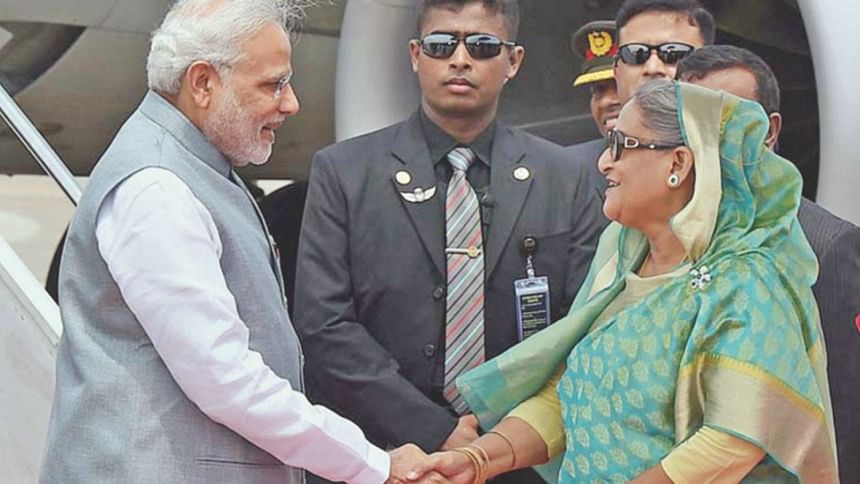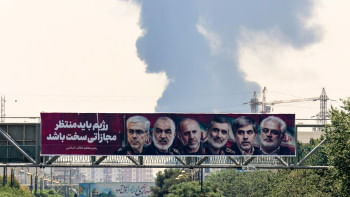Pegging Sub-regionalism with Bilateralism

The successful conclusion of Prime Minister Modi's visit to Dhaka is important for both its content and symbolism. The 60-point Memorandum of Understanding (MoU) and 22 agreements that were exchanged between the two countries provide an insight into the huge potential the two countries have in building a fruitful relationship. Modi's visit was also symbolic and he succeeded in winning the heart of the people with his use of Bangla in his speech.
His visit reflects a continuum in the foreign policy charted by the previous government. It attested to the fact that there exists a bipartisan consensus among the political class in India to take the relationship further. It silenced the sceptics on both sides of the border, especially those who perceived Prime Minister Modi only as a leader of a Hindu nationalist party and felt that it would not exhibit the same bonhomie as was seen between the Awami League government and the Congress Party that led the previous United Progressive Alliance (UPA) government. After proving his detractors wrong Prime Minister Modi assured that India will deliver on its promises to Bangladesh.
The unanimous political consensus that was displayed during the passage of the LBA and his ability to generate a consensus in the Parliament attested his ability to move beyond party lines and ideological divide. Keeping the controversy out of the bilateral context of some agreements he said, "We are successful fellow travellers on the road to development." Few important points in the MoU deserve attention as they have the potential to transform the bilateral relations as the documents succinctly captured the objectives when it described it as Notun Projonmo-Nayi Disha.
The sub-regional content was provided prominence in the MoU and it attested that the two countries would take the Bangladesh-Bhutan-India-Nepal (BBIN) framework to optimise the cooperation and move beyond the bilateral framework on issues of regional connectivity, power generation and grid connectivity. The BBIN countries have already agreed to sign a multimodal transport agreement in February this year and they are going to finalise the agreement this month when the four countries meet in Dhaka.
Connectivity has been a major issue in this sub-region that had in the past acted as a single economic unit in the past. While SAARC failed to take up the regional multi-modal transport connectivity to its logical conclusion due to the unwillingness of Islamabad, the four countries decided that they will move ahead with sub-regional connectivity while striving to achieve regional connectivity. These countries are also part of the larger Asian Highway and railway network.
Bangladesh and India are also part of the BCIM corridor. Furthermore, these countries are working for connectivity within the BIMSTEC countries. BIMSTEC electricity grid and Free Trade Agreement are being planned to integrate this region to the South East Asian countries. India has extended a further line of credit of $2 billion- a substantial part of which is going to be spent on improving road network which forms a large part of connectivity apart from rail and waterways that have been the lifeline of economy in this region. India's assurance to enhance the navigability of the waterways will help to keep the channel open throughout the year and help in trade.
Private players have been brought in to provide necessary capital investment in generating power. Two Memoranda of Understandings (MoUs) have been signed between Power Development Board of Bangladesh and two Indian companies – Adani Power Limited and Reliance Group – to set up 4,600-megawatt power plants in Bangladesh. Jointly they are going to invest $5.5 billion. Already the India-Bangladesh joint venture company, the Bangladesh-India Friendship Power Company, is engaged in the Rampal power project that would generate 1320 MW of power. There was a proposal to enhance grid connectivity to connect the Western side of Bangladesh to the Indian electricity grid and to increase supply of power to Bangladesh to 1000MW using the Bheramara-Berhampur grid interconnection. The annual energy dialogue would help the two countries to undertake comprehensive cooperation covering the entire gamut of energy resources.
The announcement of Special Economic Zones in Mongla and Bheramara would further help in addressing the huge trade gap by producing commodities keeping in mind the large Indian market. The two countries are going to further improve the Land Custom Station in the border for smooth facilitation of trade. The coastal shipping arrangement will open new avenues for boosting economic ties. The MoU to provide the usage of Mongla and Chittagong ports to India constitutes a significant aspect and should be seen in the larger context of sub-regional connectivity and trade. With the demarcation of the Maritime boundary, the two countries have now decided to increase their cooperation on Blue economy in the Bay of Bengal and Indian Ocean.
What has been a very significant aspect of the visit is India's assurance on reaching an interim agreement on the sharing of Teesta as well as the larger issue of sharing of international rivers. India assured Bangladesh that it would take the country along while deciding on the Tipaimukh Hydro-Electric project. It would not take any unilateral action on the Himalayan component of the river interlinking project, thereby, assuaging anxiety over the issue. Both the countries reached an understanding for a project under the India Endowment for Climate Change in SAARC.
Flagging off new bus services – the Kolkata-Dhaka-Agartala and the Dhaka-Shillong-Guwahati bus services along with the opening of a Deputy High Commission office in Guwahati, upgrading Bangladesh Visa office in Agartala, opening of Assistant High Commissions of India in Khulna and Sylhet, and the liberalisation of the visa regime will certainly help in greater connectivity between the people.
Without the connectivity of mind, physical connectivity becomes difficult to sustain. Prime Minister Modi's meeting with Begum Khaleda Zia, the leader of the Bangladesh Nationalist Party (BNP), also sends the right message that India is willing to engage with all the political stakeholders in Bangladesh to transcend bilateral ties.
As Modi underlined the reality of geographical proximity combined with the excellent working relationship that the two countries share, the dream of Notun Projonmo is truly not very far.
The writer is Research Fellow, IDSA.

 For all latest news, follow The Daily Star's Google News channel.
For all latest news, follow The Daily Star's Google News channel. 



Comments